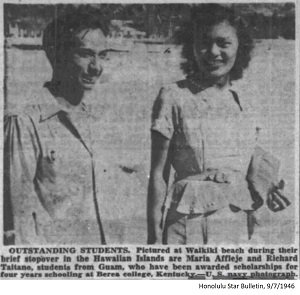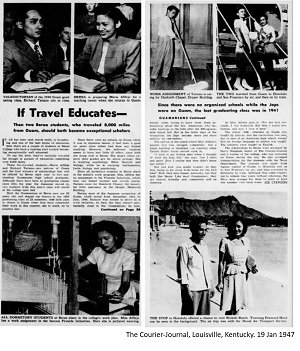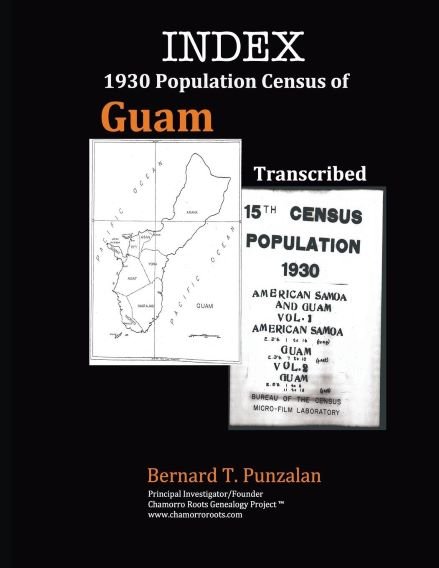Home
Håle' CHamoru - CHamoru Roots Workshop Announcement
- Details
- Written by: Bernard Punzalan

|
Yes, I would like to attend the workshop. Light lunch included. Reserve my seat. |
No, I will not be able to attend but would like to take advantage of the promotion special for a one-year access to the database and four (4) census eBooks. |
This a one-time promotional special offer for those who would like to attend the first Chamorro Roots Genealogy Project Workshop and those unable to attend but are interested in taking advantage of this special offer:
What: Håle' CHamoru - CHamoru Roots Workshop
Who: Conducted by Bernard Punzalan, Founder
Where: Hotel Santa Fe, Tamuning, Guam
When: April 27, 2020 (8:00am-12:00pm)
Note: Registration is limited to 10 per workshop and a minimum of 5 to recover venue costs. Workshop attendees should bring their laptops or tablets for hands-on support and assistance. I realize that not everyone will be able to attend the Workshop, so I added an option for those who cannot attend but would like to take advantage of saving $75 (one-year subscription and four Guam Census eBooks). There will only be 20 of this special price promotion offering and will be on a first come first served basis.
Registration includes:
- One-year subscription to the on-line Chamorro Roots Genealogy Project ($60 value)
- Four (4) eBooks ($115 value) – 1920 and 1930 Census transcription eBooks; and, 1920 and 1930 Census Index eBooks
- Light refreshments for Workshop atttendees
- Proceeds are to help with costs to sustain the Project, si Yu'os ma'ase.
Once purchased the download links will be available on your "Store Purchases" menu for each of the files. The download link will be available for 90 days from the date of purchase. Because access to download these eBooks will be immediately available upon purchase no refunds can be made.
For access to the Chamorro Roots Genealogy Project database and other eBook resources, I will notify you of availability once I have fully completed integrating your registration purchase.
CHamoru Genealogy, Identity and Its Impact from U.S. Census Questionnaires
- Details
- Written by: Bernard Punzalan

Figure 1. 2020 U.S. census questionnaire
For the first time in Guam and Commonwealth of the Mariana Islands (CNMI) history, the 2020 Census produced the first questionnaire that does not distort the ethnicity/race of the “Chamorro” people. In order to get a better understanding to certain components of this issue, one must learn the political and colonial history of the partition of the Mariana Islands, Guam from its sister islands. Below is a short historical summary that has affected the true population count of the CHamoru people under the U.S.
Guam was ceded by Spain and became a colony of the U.S. in 1898. As for the rest of the Mariana Islands, Spain sold them to Germany after the Spanish-American war in 1898, but they did not become a U.S. colony until after World War II against Japan. After all the war and turmoil between colonial empires, the first U.S. decennial population of Guam did not occur until 1920, while the CNMI was not included until 1970.
From 1920 – 1960, the U.S. census questionnaires were completed by census enumerators, which left them with the power of the pen in recording how names and family information were recorded. Some included spelling variations among other transcription errors. But in 1970, the U.S. census questionnaires became self-enumerated, which gave the power of the pen back to the owners of information. There was also a blank space to write-in “Chamorro,” as a “Color or Race.”
Come 1980, the U.S. census questionnaire for Guam as an unincorporated territory of the U.S., and for the first time, included the term “Guamanian” as a race. This term reinforced a negative stigma from World War II and exacerbated the partition of the CHamoru people between Guam and the CNMI. On the other hand, the census questionnaire used for the rest of the Mariana Islands, at the time a U.S. Trust Territory of the Pacific Islands, was more specific and one could write-in “Chamorro.”

Figure 2. 1980 ethnic census option for Chamorro people residing on Guam or U.S.

Figure 3. 1980 ethnic census option for Chamorro people residing in Northern Mariana Islands or other Trust Territories
In the 1990 census questionnaire “Asian or Pacific Islander (API)” was introduced and again included “Guamanian” as an option and added “Other API” with a space to write-in a race. However in the 2000 and 2010 census, enter the “Guamanian or Chamorro,” option. Sigh…
So when the opportunity comes, please ensure that you and your family are among those enumerated in the 2020 census. One important reason to do so is that the data will be analyzed and typically used for decision making purposes. Therefore, depending on the nature and what type of decision may need to be made, will be contingent and dependent on the data collected to date. If one does not have the appropriate data, s/he might not be able to make a more suitable decision that can impact the lives of many. In particular, a faulty decision could result in an adverse impact/unintended consequence of loss of benefits, programmatic or funding opportunities, and the list can go on.
And finally, we must never forget that we are an ethnically and culturally unique people in this world. This is all a part of the Chamorro Roots Genealogy Project.
CHamoru-ham maseha månu gaige ham! [We are CHamoru, no matter where we may be!]
See also: Is "Guamanian" an Ethnic Race?
Project Updates/Upgrades in Progress/Status
- Details
- Written by: Bernard Punzalan

Håfa Adei!
For the past few months I have been working on system updates and technology advances to benefit the Project in the near future. I must admit that it’s taking me much longer than expected. As technological advances continue at a light speed pace, I am not as quick to assess impact and keep up with the changes. But rest assured, I do my best to ensure that the system remains accessible and security of the data remains in tact.
The biggest side project for me has been trying to configure, sustain and run a private cloud server parallel with what you see on-line. I hope to complete that project within the next few months and demonstrate its capabilities that will also help me to reduce many of the time consuming work-arounds just to maintain for the Project’s current server.
I will also be on Guam from April 23 to May12, 2020. When I am there I hope to be able to conduct a hands-on Chamorro Roots Genealogy Project workshop. I am almost finished with the planning on that event and will announce it soon.
I also want to thank everyone who has either subscribed or donated to keep this project on-line.
Miggai ma’åse nu hamyu!
Bernard
Copies of Birth, Death or Marriage Certificates
- Details
- Written by: Bernard Punzalan
CNMI
- Copies of birth (uncertified), death (uncertified), marriage (certified): http://www.justice.gov.mp/uploads/Commonwealth_Recorder_5-27.pdf
- Certified birth and death records: https://www.chcc.health/healthvitalstatistics.php
Guam
- Application for copy of birth, death or marriage certificate on Guam: http://www.govguamdocs.com/dphss/docs/VitalStatistics/ApplicationforCopyofBirthMarriageDeathCertificate.pdf
1946 - Richard Flores Taitano and Maria Aflleje
- Details
- Written by: Bernard Punzalan


Pictured in 1946 is Richard Flores Taitano and Maria Aflleje, with a layover in Hawaii and enroute to Berea College, Kentucky. The second photo was featured 1947 in the The Courier-Journal, Louisville, Kentucky during their attendance at the college.
Richard Taitano served many years as a public servant with many accomplishments. He was the Valedictorian for his 1940 class on Guam. For more information about him see: https://www.guampedia.com/richard-flores-taitano/
If anyone has information or stories to share about Maria Aflleje, I would certainly appreciate adding it to the Chamorro Roots Genealogy Project. Her education and training at Berea College was prepping her for a teaching career on Guam.
Page 23 of 81



